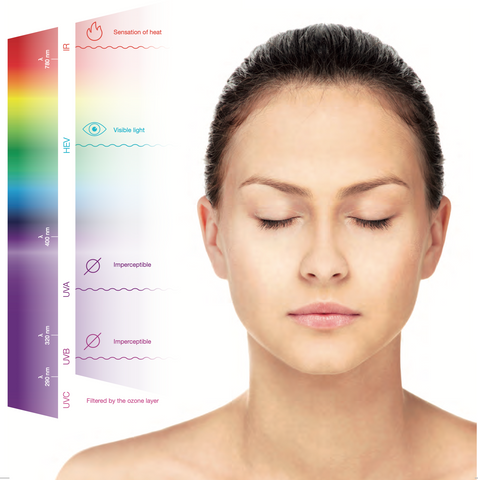visible light (HEV) and infrared radiation (IR).

Understanding the full spectrum
UV RAYS
The sun emits three types of harmful rays: UVA, UVB and UVC (dont worry about this for now). UVA rays penetrate deep into the skin, causing premature aging, wrinkles, disrupting your collagen and potentially skin cancer. UVB rays, on the other hand, are responsible for sunburns and can also contribute to skin cancer.
High Energy Visible (HEV)
You also have High Energy Visible (HEV) light, also known as blue light. This is a type of light that is emitted not only by the sun but also by digital screens, LED lights, and fluorescent lights. Recent studies suggest that prolonged exposure to HEV light may have harmful effects on the skin, similar to UVA and UVB rays. HEV light penetrates deeply into the skin, even deeper than UVA and UVB rays. This deep penetration can lead to oxidative stress, which produces free radicals. Moreover, HEV light has been shown to induce hyperpigmentation, especially in darker skin types. According to research by Dr. Pearl Grimes, "OPN3 regulates melanocyte activity and is responsible for the persistent hyperpigmentation induced by blue wavelengths of visible light." Consequently it can exacerbate conditions like melasma and post-inflammatory hyperpigmentation. This is particularly important in our digital age, where most of us spend hours each day in front of screens.

Infrared (IR) radiation
Infrared (IR) radiation, similar to UV and HEV light, is another component of the sun's rays that can have detrimental effects on our skin. Infrared radiation is divided into three types: IRA, IRB, and IRC. Among these, IRA (Infrared-A) is of most concern when it comes to skin health as it penetrates the skin more deeply than UV and HEV light.
Prolonged exposure to IRA can lead to increased skin temperature, which in turn can cause inflammation, premature aging, and damage to the skin's DNA. It can also lead to the breakdown of collagen, the protein that keeps our skin firm and elastic, and the production of free radicals, which can further damage skin cells. This is where IR filters come into the picture. IR filters are designed to protect the skin from the harmful effects of infrared radiation. They work by reflecting or absorbing the IR rays, preventing them from penetrating the skin.

The Importance of a Quality Sun Protector
- Prevents Skin Cancer: Regular use of a quality sun protector is one of the most effective ways to reduce the risk of skin cancer, including melanoma, the deadliest form of skin cancer.
- Protects Against Premature Aging: Sun damage is a leading cause of premature skin aging. By blocking UVA rays, sun protectors help prevent wrinkles, fine lines, and age spots, keeping your skin looking youthful and healthy.
- Prevents Sunburn: Sunburn is not just painful but also harmful to your skin. Repeated sunburns can lead to long-term skin damage. A quality sun protector absorbs or reflects the sun's UVB rays, preventing sunburn.
- Protects Sensitive Skin: For those with sensitive skin, sun exposure can lead to rashes, redness, and irritation. A quality sun protector designed for sensitive skin can help prevent these issues.
- Protects Against Blue Light: This is particularly important in our digital age, where most of us spend hours each day in front of screens. HEV filters are an important addition to our skincare arsenal. They offer comprehensive protection against the full spectrum of light that can damage our skin, promoting skin health and helping to keep our skin looking youthful and vibrant.
- Protects Against DNA Damage: Especially with IR rays, this can lead to increased skin temperature, inflammation, premature aging, damage to the skin's DNA, breakdown of collagen, and further damage to skin cells. IR filters offer an additional layer of protection against the sun's harmful rays, helping to keep your skin healthy and youthful.
- Promotes Skin Health: By protecting your skin from harmful UV, HEV and IR rays, sun protectors also help maintain the overall health of your skin. They preserve the skin's essential proteins, such as collagen, keratin, and elastin, which keep your skin smooth and firm.

When choosing a sun protector, look for a broad-spectrum formula that protects against both UVA, UVB, HEV, and IR rays. Sun damage is not exclusively due to UVA and UVB radiation, visible and infrared radiation play a very important role. Therefore, look for photoprotectors that offer broad-spectrum protection.The American Academy of Dermatology recommends using a sun protector with an SPF of 30 or higher. Also, consider your skin type and lifestyle. If you have sensitive skin, opt for a fragrance-free and hypoallergenic formula. If you're active or spend a lot of time in the water, look for a water-resistant or sport formula.
A quality sun protector is a non-negotiable part of any skincare routine. It's an investment in your skin's future, offering protection against skin cancer, premature aging, sunburn, and more. So, whether it's a sunny summer day or a cloudy winter afternoon, don't forget to apply your sun protector. Even the more sensitive areas of your face, such as your lips and eye contour. Your skin will thank you.
SHOP MY FAVORITE MESOESTETIC AND SONREI SUN PROTECTORS HERE
Reference:
Bernstein, E. F., Sarkas, H. W., & Boland, P. (2020, November 18). Iron oxides in novel skin care formulations attenuate blue light for enhanced protection against skin damage. Journal of Cosmetic Dermatology, 20(2), 532–537. https://doi.org/10.1111/jocd.13803
